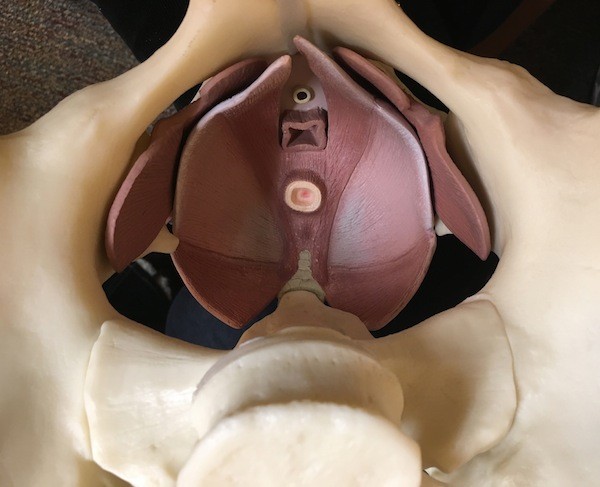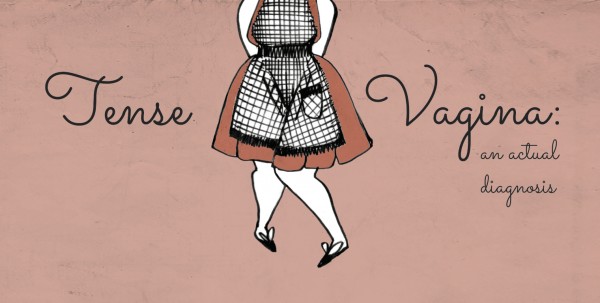Sara Juli is not afraid to tackle personal issues in a public forum. She’s a dance artist who has been creating and performing solo work since 2000.
She has danced about fear and shame and anger. In 2006, she offered audiences her life savings — $5000 — in The Money Conversation. In 2008, after losing her father to cancer, she addressed the taboo topic of death in her piece Death.
And now, the topic is tense vaginas. Her tense vagina. The title of her upcoming dance theater performance is Tense Vagina: an actual diagnosis.
She means for you to laugh, but she also wants you to take her performance seriously. She will use “humor, movement, sounds, songs, text and audience participation to reveal all this is awesome and all that sucks when it comes to being a mother.”
Tense Vagina was born out of a problem Sara shares with countless other mothers. After having two children, she had trouble controlling her bladder.
“I had a lot of urgency,” she explains, “or always felt like I had to pee and then would go to the bathroom and nothing would happen. I was never comfortable because I was always nervous about whether I’d be near a bathroom or if there wasn’t any bathroom. It was a mess, but I didn’t talk about it. I didn’t know how to talk about it.”
Her bladder issues began after her first child was born six and a half years ago. Too busy being a new parent, she didn’t do anything about it. When she had her second child two years ago, things got worse. Still, she said nothing.
“It was one of those things,” she says. “Like many women, you kind of A, ignore it because you’re putting so much energy into raising your child or children. You’re like eh, I don’t have time for me, which I’m most positive is very common. And B, it’s too embarrassing to talk about.”
The crux of Sara’s issue lay in her pelvic floor muscles. We all have them — woman and men. Layers of muscles that stretch like a hammock from your pubic bone in the front to the base of your spine in the back. They’re necessary because they support your bladder and rectum and if you’re a woman, your uterus. They also contribute to sexual function and help control your bladder and bowels.
When those muscles are weak, here are some of the things that can happen:
- accidentally leaking urine when you exercise, run or jump, laugh, cough or sneeze
- needing to run to the toilet and not making it in time
- constantly needing to pee
- feeling the urge when there’s nothing in your bladder (or bowel)
- accidentally losing control of your bladder or bowel
- pain in your lower abdomen or pelvis
- painful sex
- prolapse (an organ drops out of position)
- women may feel as if something is bulging into the vagina
- men may feel a bulge in the rectum
A year ago, Sara and her family moved to Maine from New York City. She mustered up the courage to mention what was going on to her new doctor at the OB/GYN practice All About Women.
“She said, ‘Oh, I’ll just refer you to the Pelvic Floor Rehab Center of New England.’ And I said, excuse me? What is the Pelvic Floor Rehab Center of New England? I mean, it blew my mind!”
The Pelvic Floor Rehab Center is a holistic physical therapy practice in South Portland that treats women, men and even children with issues related to dysfunctional pelvic floor muscles.
Women
- urinary or bowel incontinence
- pelvic pain
- colorectal disorders
- pre and post natal issues
Men
- chronic pelvic pain
- coccydynia
- pain after prostate surgery
- incontinence
- nerve pain
Children
- difficulty controlling bladder or bowels

Physical therapist Susan Ramsey opened the Center 13 years ago. She became interested in pelvic floor rehab when she did physical rehab with geriatric patients. She saw women who were living in nursing homes because they were incontinent. By teaching them how to strengthen their pelvic floor muscles, some were able to return home. She also saw people who had broken their hips. She wondered, if, for some, weak pelvic floor muscles were to blame. That’s because she discovered several of them fell hurrying to the bathroom in the middle of the night because they worried they wouldn’t make it in time.
Pelvic floor rehab is a subspecialty within physical therapy that requires extra training. When Susan opened her practice, she focused not on geriatric patients, but on women with pelvic pain, which was a huge issue. Within six months, she had to hire a second person. Today, she has a staff of 25, including 10 specially trained pelvic floor physical therapists, three pelvic floor physical therapist assistants, and three pelvic floor athletic trainers.
“They are physical therapists for your vagina!” exclaims Sara. “First of all, why isn’t that part of the mainstream? Why didn’t I know about them before I was pregnant or at least in the six and a half years that I’ve had the problem?”
At her first visit, Sara started choreographing her performance. “The physical therapist put her fingers inside my vagina to measure the strength of the muscles,” she says. “When she removed them she said to me, ‘Well, you have a tense vagina.’ The minute she said it I said I will be naming my next dance that, thank you very much.”
Sometimes the visits were awkward and uncomfortable (not physically), but what Sara learned about her body and how she could control her bladder problems was amazing. The crux of her treatment was learning how to do Kegel exercises properly and doing them while she was also doing different types of sit-ups, pilates and yoga, using a vibrator and doing other specific exercises meant to release and strengthen her pelvic floor muscles.
Want to know more? Go to Sara’s performance. (I’ll give you details at the end of the post.) She’s not afraid to talk about any of it. Even using a vibrator. Its purpose in treating pelvic floor dysfunction is to release tense muscles, but who doesn’t think sex when they think of a vibrator? “My performance is not about sex,” says Sara, “but that’s the funny part of living with a vibrator. It can have multiple meanings.”
“Muscles are muscles are muscles,” points out Susan Ramsey. “We try to keep the rest of our muscles in shape, but never think about our pelvic floor muscles.”
Sara wonders why the doctors who delivered her babies never mentioned those muscles. Like her, many women suffer in silence — for years, sometimes forever.
“From my perspective, it’s all about educating women early,” says Susan. “It doesn’t take a lot to teach women how to find, feel and move their pelvic floor. The critical piece is teaching them how to move it correctly. During pregnancy and birth, it’s the pelvic floor muscles that are stretching to open. Having a baseline evaluation of pelvic floor muscle strength and tone can be helpful and prevent problems.”
It may have taken her six and a half years to get there, but after three months of seeing her physical therapist every week and dutifully doing her homework assignments, Sara no longer has a problem.
“I’m totally fixed!” she says. “Completely. I now understand the diagnosis. I understand the condition. I understand how to manage it. I understand how to treat it. I understand what’s happening and I am shouting from the rooftops. I want to share this knowledge because I went from having what I would describe as a broken vagina to a perfectly functioning happy one.
If you want to learn more about Sara’s experience and have a good laugh, you can see Tense Vagina: An actual diagnosis this Friday or Saturday at Space Gallery in Portland
Tense Vagina: an actual diagnosis
Saturday, October 24, 2015
8:00 pm
Space Gallery
538 Congress Street
Portland, Maine
207.828.5600





I went to Pelvic Floor Rehab as a way to prepare for my prostate cancer radiation treatments. I felt that keeping those muscles strong would help me deal with any possible side effects of the radiation or the cancer. I can report that I have had none. No problems with incontinence or anything. In addition I learned so much about how important keeping my pelvic floor strong and using it correctly is to my overall muscular health, my posture, and so much more. What they teach there could be useful to pretty much anyone.
Bill,
Thank you so much for sharing your story. I know other men have similar issues and I’m sure they’ve never even heard of pelvic rehab therapy. Or if they have, they assume it’s only for women. I’m happy to hear that you’re doing well, too.
I have moved my bed within inches of the bathroom,
And I know you’re not suppose to drink water, for a
long time before ggoing to sleep, that never happens.
The one thing, is that i NEVER knew, so many,
suffer in silence
Nancy, I think it’s amazing that so many people suffer lots of different things in silence.
Is this on DVD? I can relate but I live in Iowa and would not be able to make the trip. At age 44 I had to do a full hysterectomy due to severe endometriosis. I’m 63 now and the last few years I find myself wearing pads probably 75% of the time. It’s embarrassing!! I have done kegels for years and still do. I’m physically very active and intend to continue. I’m 5’2 and 115 lbs. At age 47 I had a major lumbar fusion and 3 titanium cages. For the most part I do very well but when I’m hurting it weakens my bladder also. Thank you for this article.
Donna, I will ask Sara if it’s going to be taped. Also, do you want me to find out from Susan Ramsey if there is a good pelvic rehab therapy practice in your area?
Donna, Got a quick reply from Sara! She says, “While I am having the performance videotaped, I do not distribute it to the public. I will have excerpts on my website: sarajuli.com a few months following the show. Tell her I’d love to perform it in Iowa!”
Love, Love, Love Susan and all the staff at Pelvic Floor Rehab, they are the most nurturing group of folks I have ever encountered.